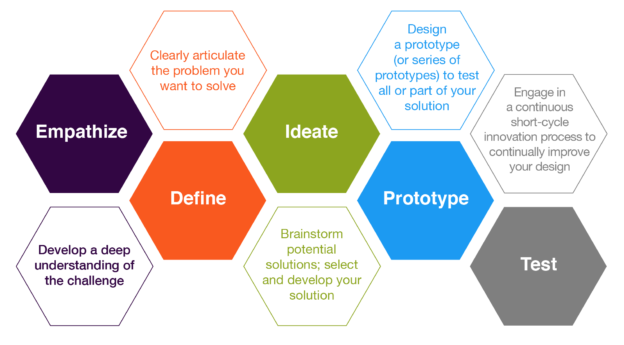Adding an extra layer of thinking, like design thinking, gives the products their competitive edge, as customer needs are met with the expected fidelity, in the modern, digitally mature, connected world.
With the increasing use of technology universally, business strategy thinking now involves an overall assessment, a 360-degree view that puts the end-user at the heart of the process. The importance of innovation and creativity in a business cannot be undermined. However, innovation in a product, now is more about process alignment that elevates customization to new levels. A completely new ‘Design Thinking’ approach, that caters to the end-user, thus involves not just a strategic look from a technology-stack lens, or a business-process lens, but keeps the ‘human-hat’ on all the time. Businesses now are more dedicated to customer/user experience, and this is a source of sustainable, competitive advantage.
Understanding the end-user promotes a culture of empathy. Further, how we access our accounts on ATMs and get results in seconds is the kind of bespoke IT that we have become used to. Therefore, while endeavoring to cater to the modern user, aiming to maintain empathy as the pivotal point while creating designs at the intersection of technology and strategy, is what gave rise to the new ‘Design Thinking’ approach.
Responding in real-time, and being able to act quickly are the centre-pieces of the new design-driven culture. Examples of design-driven thinking include tech-enabled, flexible and hybrid workspaces that make it easy for collaborators and employees to come together quickly.
Rooms are set up so that hybrid teams sit together, breaking down traditional barriers, to make it easier to work together, easier to gather ideas and share inputs, and easier to keep humans first, before rolling off successful products to market quickly. Such digitally integrated “on-demand” teams enable co-working with an extensive network of technical experts and professionals, spread across geographies.
This leads to a win-win situation for all, helping in employment generation, and increasing the enterprise’s capabilities, agility and resilience. The increase in gig workers helps companies tap into the “digital native” generation. That’s how design-driven cultures embrace the intangibles which catalyze innovation, align teams and allow businesses to have a greater impact.
Such design thinking has ensured business continuity and empowered sustainability in the turbulent times of Covid. It has helped in curating delightful, engaging experiences and the creation of ‘successful’ products.
In HR, design-led thinking puts the employee at the heart of the engagement. As the world moved to hybrid workplaces, HR teams have re-engineered the processes of hiring and assessments to make sure that there are no snags in workflows and there is enough support for the workforce. Ensuring that the new talent has the same empathetic drive, and the ability to keep in mind who they’re designing for, is part of the new design thinking culture that HR teams imbibe. Empathy is endemic to the new design cultures.
Within an office, connected workplaces are not just about technology. The incorporation of design thinking leads to seamless connectivity and communication between various elements of an IoT-based ecosystem. The key lies in embracing a design approach that facilitates boundary-less communication. The design thinking company takes people along the way towards achieving talent attraction, employee productivity, employee satisfaction, employee retention and engagement.
By incorporating Machine Learning and the Internet of Things (IoT), we are now able to engage the customer in a very different way, on an ongoing basis, with relevant information, in real-time. Uber and Airbnb, for example, have demonstrated some of the different ways of bringing the user experience into the forefront.
Our enjoyment of objects or services is heightened because of the care the designer/management took in meeting our needs or the care taken in the seamless deployment of services. Design thinking is a similar problem-solving, solution-driven approach that workplaces employ to achieve better results.
Technologists now use design much earlier in the process, in an integrated way. Instead of having siloed approaches to designing products/services, now we have integrated conversations. It brings many new capabilities into the operations, and the end product creates signature moments of delight for the customer at any given point in time. Design thinking thus becomes a strategic business lever.
The earlier way of thinking involved building the product first, and the interactions came later. Now there are multiple channels to gather data about users to be on top of the game to ensure more fulfilling one-to-one experiences. ML and data acquisition measure those experiences and those design moments before they even become part of the new business model/product. Adding an extra layer of thinking, like design thinking, gives the products their competitive edge, as customer needs are met with the expected fidelity, in the modern, digitally mature, connected world.
https://cio.economictimes.indiatimes.com/news/strategy-and-management/setting-the-new-paradigm-with-design-thinking/85027523





